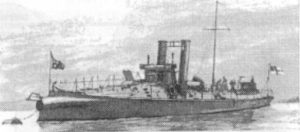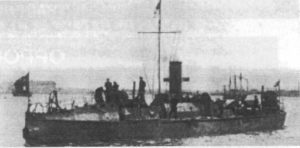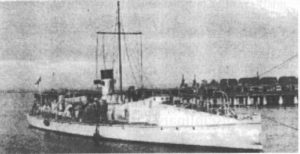- Author
- Swinden, Greg
- Subjects
- History - general, Ship histories and stories
- Tags
-
- RAN Ships
- HMAS Childers (HMVS), HMAS Countess of Hopetoun (HMVS)
- Publication
- June 2000 edition of the Naval Historical Review (all rights reserved)
The Navy also quibbled over the cost of the tug hire when the bill from Huddart Parker Limited, for 176 pounds and 8 shillings, came in for the use of the tug Nyora. They considered the hourly rate of seven pounds and seven shillings for 24 hours was excessive and that the Navy should not have to pay for the transit time it took the tug to reach the stricken vessel. After much wrangling between Navy Office and Huddart Parker Limited the full bill was paid.
The final chapter in this whole saga occurred in late 1922 when a small brown package arrived at the home of Emily Baker. Inside was her son’s standard issue British War Medal.
BIBLIOGRAPHY
Gillett, R. Australia’s Colonial Navies, Naval Historical Society of Australia, Sydney 1982.
Lind, L. The Royal Australian Navy – Historic Naval Events Year by Year, Reed Books 1986.
Navy Office File 16/16/517 (HMAS Countess of Hopetoun – Minutes of Court of Inquiry re Breakdown of the Vessel and the Death of Signalman S. Baker RANR) held at the Australian Archives Melbourne.
CHILDERS
First-class Torpedo-boat 1883
DISPLACEMENT: 63 tons
LENGTH: 118 ft 2 in (36.01 m) overall
BEAM: 12th ft (3.81 m)
DRAUGHT: 5 ft 9in (1.75 m)
HULL CONSTRUCTION: Galvanised steel; divided into watertight compartments by eight bulkheads
ARMAMENT: Two 14-in (356-mm) torpedo-tubes, one of which was fitted in the bows; four sets of torpedo dropping-gear, two Hotchkiss 1-pounder machine guns.
MACHINERY: Single screw
HORSEPOWER: 750
SPEED: 19½ knots
COAL CAPACITY: 10 tons
COST: £10,500
COMPLEMENT: 12

Childers, the first torpedo-boat acquired by Victoria, was built by Thomycroft’s, of Chiswick, London. She was named in honour of a prominent Victorian Government official who, after his return to England, became First Lord of the Admiralty. Launched in 1883, Childers was very well fitted out and her equipment included a searchlight.

For her delivery voyage to Australia she was commanded by Lieutenant T.H.M. Jerram, RN (later Admiral Sir Martyn Jerram, who commanded the Second Battle Squadron of the Grand Fleet at Jutland, 1916). Leaving Portsmouth on 3 February 1884, Childers was accompanied on the voyage out by the gunboats Albert and Victoria, which joined her at Malta. The three vessels were made available at Port Sudan for use by the Royal Navy in the Egyptian Campaign, but were not actually involved in hostilities. In order to conserve coal Childers was towed across the Indian Ocean by Victoria. Sailing via Batavia, Torres Strait, Brisbane and Sydney, the trio arrived in Port Phillip Bay on 24 June 1884.
Following service with the Victorian Navy, Childers became a unit of the Commonwealth Naval Forces after Federation in 1901, and then of the RAN in 1911. During World War I she undertook patrols in the Port Phillip Bay area, and also acted as tender to Williamstown Naval Depot. She was sold as scrap in August 1918 for the sum of £20.
COUNTESS OF HOPETON
First-class Torpedo-boat 1891
DISPLACEMENT: 75 tons
LENGTH: 130 ft (39.62 m) overall
BEAM: 13½ ft (4.11 m)
DRAUGHT: 5 ft 7 in (1.70 m)
ARMAMENT: Three 14-in (356-mm) torpedo-tubes, one of which was fitted in the bows, the others in a twin revolving mount; four sets of torpedo dropping-gear, two 2-barrel Nordenfelt 1-pounder machine guns.
MACHINERY: Single screw
HORSEPOWER: 1, 100
SPEED: 19½ knots
COAL CAPACITY: 20 tons
COST: £12,500
COMPLEMENT: 19

Countess of Hopetoun was the last vessel built for the Victorian Navy. She was constructed by Yarrow & Co., of Poplar, London, and named in honour of the wife of the Earl of Hopetoun, Governor of Victoria from 1889 to 1895. Countess of Hopetoun was launched in 1891 and sailed for Australia via the Cape of Good Hope. The builder’s contract included delivery to Victoria, and for the long voyage out she was temporarily rigged as a three-masted schooner. The passage, mostly under canvas, took about seven months.

After Federation in 1901 Countess of Hopetoun became a unit of the Commonwealth Naval Forces and subsequently of the RAN in 1911. During World War I she carried out patrol duties in Port Phillip Bay and acted as tender to Williamstown Naval Depot. After the war she was used for training purposes, but was eventually laid up, and disposed of in April 1924.
SPECIAL NOTE
Countess of Hopetoun bore the longest name on record in the RAN. She was the last warship to be ordered by an Australian colony.




